Check out this post several School Day Activities for Elementary Education, to work in the classroom or as a homework assignment.
An institution so important to the world could not fail to be honored. In day March, 15, we celebrate the School Day. After family contact, it is the school that plays the most important roles in the children's lives, such as literacy and the duty to prepare the little ones for life in society.
See also:
And it was with this in mind that we selected these wonderful School Day Activities for Elementary Education, ready to print, check out:
Index
Describing my school:
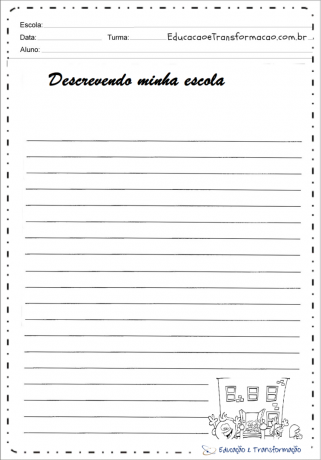
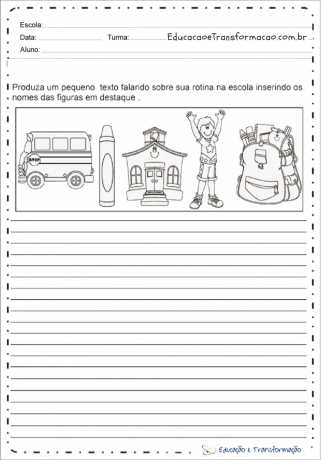
School Day Activities for Elementary Education
Talk about your school:

Write what you like most about school:
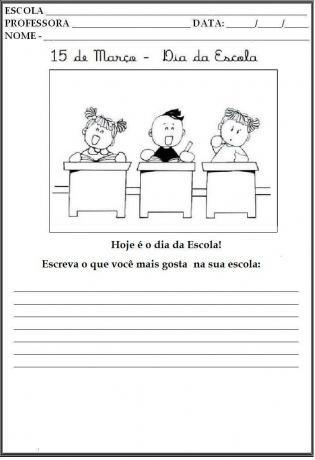
Also check out:
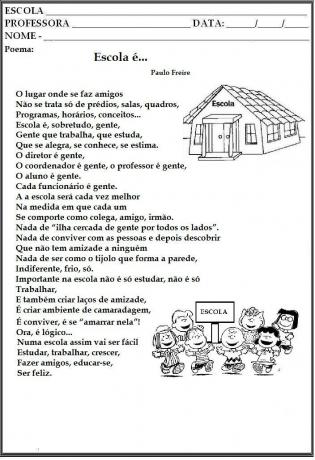


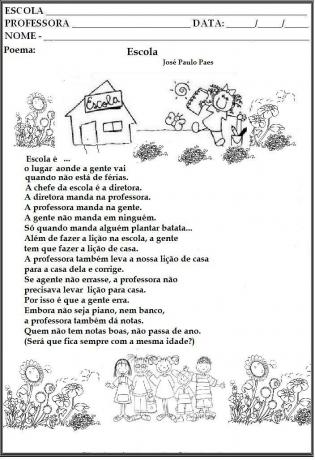

Also see:
A song idea for this date is the composition and lyrics of Erasmo Carlos, School Day, from the years as a young guard, but which represents the school day very well and can be the soundtrack for the opening of the parties to celebrate this date.
hits the school bell
It's snack time, I don't even care
I get the guitar and go to the salon
And I make up the mess
And if the master tells me to stop playing
The whole class will scream….
boy play that rock'n roll
while i play glad i'm
And when the bell rings again
So I go back to studying
AGE: 7 years old
Specific Objectives: Hearing, Attention
MATERIAL: Scarves
LOCATION: Room, court, patio
Formation: circles
Organization: students in circles going two to the center; one will be the dog and the other the cat. seal both eyes
Execution: every time the dog barks the cat will meow and the dog will try to catch it. If you succeed, others will go to the center.
AGE: 9 years onwards
SEX: Both
Specific objectives: Develop the sense of smell
MATERIAL: Fruits, perfumes, lotions, etc.
Formation: circles
Organization: students in circles, with one going to the center blindfolded
Execution: the teacher will give the students at the center something to smell the perfume and will say: – you will have to recognize this aroma among others that I will give you. Then it will give other things (fruit, bleach, etc.). This should identify when they give you to smell something that has the same smell as the first.
AGE: All
Specific objectives: Development-perspective
LOCATION: Open air, lounge
Formation: circle
Organization: students sitting in a circle. In the center, a blindfolded colleague
Execution: A fellow member of the circle will stand up, touch the little blind man and sit down again. From the movements made, the blind man will try to guess who touched him.
AGE: 9 years old
Specific Objectives: Attention, acumen
MATERIAL: Ball
LOCATION: patio, lawn
Formation: circle
Organization: Students in a circle, legs crossed, one student sitting in the center blindfolded.
Execution: teammates pass the ball among themselves and at the teacher's signal they put their hands behind them, hiding the ball. The student in the center opens his eyes and points out the one who imagines he has the ball. If you make a mistake, repeat the game.
AGE: 8 years onwards
Specific objectives: Develop imagination
MATERIAL: A bottle
LOCATION: Room, patio
Formation: circle
Organization: students in a circle, the teacher in the center.
Execution: the teacher rotates the bottle on the ground and when it stops it will point towards a student. The student must go to the center and perform a task determined by the class or teacher.
AGE: 9 years onwards
Specific Objectives: Emotional Control
MATERIAL: Apple
LOCATION: Court, patio
Formation: ranks
Organization: in rows, with apples hanging in front of them
Execution: at the signal, try to bite the corresponding apple, without holding it, within a specified time. The row with the highest number of points per bite, or the one that bites the apple first, or the one that eats the apple first wins.
AGE: 7 years old
Specific objectives: Attention, listening
MATERIAL: Any object
LOCATION: patio, lawn
Formation: circle
Organization: students in circles. One sitting in the center with eyes blindfolded, which will be the dog. Near you will be an object "the bone"
Execution: given the signal, the teacher will indicate one of the students in the circle who will cautiously try to pick up the bone. Perceiving the noise, the dog will bark and indicate the side of the noise. When setting the direction, the teacher will indicate another student. If one succeeds and is not guessed, take the sales and try to guess.
AGE: 7 years onwards
Specific objectives: Attention, agility
MATERIAL: Balls
LOCATION: Court, lawn, patio
Formation: circle
Organization: in a circle, with two students facing each other, in possession of a ball. One ball will be designated “MICO”.
Execution: at the start signal, the students who have the ball pass it to their partner on the left, who quickly does the same and so on. The balls are passed, the objective is to make one ball reach the other, that is, that the "cheek" is caught and everyone prevents this from happening in their hands. Whoever drops the ball must retrieve it alone and return to his place to start passing it again. Each time the tamarin is caught, the game is interrupted and the student who allows it will remain in the center until replaced.
Specific objectives: Motor coordination, rhythm, attention
LOCATION: Outdoor and living room
Formation: circle
Organization: pupils numbered successively forming a circle in the “sitting” position. Everyone starts the game by tapping twice and snapping their fingers once on their right and left hands.
Execution: a student, by snapping the fingers of the right hand, says its number and by snapping the left hand, it calls a corresponding number, to a partner. The one who is called will continue the game by saying his number and calling another one. Whoever makes a mistake and whoever calls the number that has already left, will also leave.
AGE: 7 years old
Specific Objectives: Attention
LOCATION: Room, court
Formation: circle
Organization: students in circle
Execution: the teacher asks if certain animals fly. If they fly, students must respond: fly and make gestures with their arms. E.g.: Chicken fly? Bird flies? Elephant fly? The student who makes a mistake will pay a gift at the end.
AGE: All
Specific objectives: Attention and prompt reaction
LOCATION: Outdoor and living room
Formation: circles
Organization: students in circles in a seated position
Execution: students numbering successively, but arriving at number 7 should say: PUM, replacing them. The student who takes time to speak or does not replace the number with Pum will leave the game every time he makes a mistake. The game is renumbered by the student placed on your right.
AGE: All
Specific objectives: Memory, insight, observation
LOCATION: Outdoor and living room
Formation: circles
Organization: a student is asked to leave the site and some modifications are made.
Execution: when the student returns, the group will start counting, increasing or decreasing the intensity of the chant as it approaches or moves away from what has changed.
AGE: 7 years onwards
Specific objectives: Develop the senses, memory
LOCATION: Courtyard and court
Formation: row
Execution: the first turning to the next and saying: “Here goes the goose”. The second will say "What goose?" To which the first responds: “The goose”. The second says: … ah … the goose. The question will be repeated and so on. So runs all the ranks.
AGE: 6 years onwards
Specific Objectives: Rhythm, Attention
MATERIAL: Lemon
LOCATION: Court, patio, living room, lawn
Formation: circle
Organization: students sitting in a circle, holding a lemon
Execution: Students will start the game by singing: My lemon, my lemon… at the same time passing the lemon to their classmates. At the end of the song, the student who is in possession of the lemon will be eliminated.
AGE: All
Specific Objectives: Memory, Touch
MATERIAL: Pencils, staples, coins, chalk, etc.
Formation: standing, forming a circle, hands behind
Execution: The entertainer will hand a student one object after another to be passed on. After all the objects are passed, everyone will sit down and quickly write the name of the objects that pass through their hands. The winner will be whoever writes the most names of the objects in a given time.

School Day Activities for Elementary Education
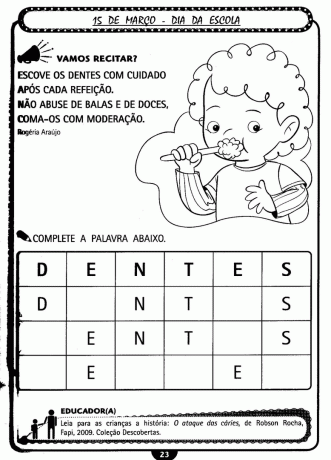
School Day Activities for Elementary Education
Subscribe to our email list and receive interesting information and updates in your email inbox
Thanks for signing up.